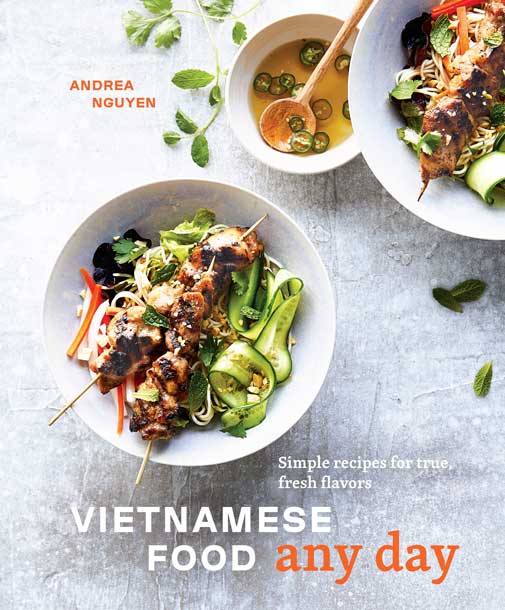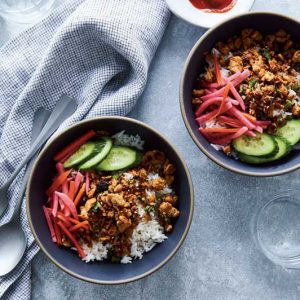 You don’t need to be a pro to create authentic Viet dishes. James Beard Award-winning cookbook author and instructor Andrea Nguyen Nguyen isn’t. She’s been demystifying Viet cuisine with clarity, cheer and fabulous recipes since her 2006 cookbook Into the Vietnamese Kitchen. She does a deep dive into Vietnamese classics with books like Asian Tofu, Asian Dumplings, The Banh Mi Handbook, and her 2018 Beard-winning The Pho Cookbook. Yet for all her culinary drive and talent, she’s entirely self-taught. She’ll teach you, too, with her new book Vietnamese Food Any Day.
You don’t need to be a pro to create authentic Viet dishes. James Beard Award-winning cookbook author and instructor Andrea Nguyen Nguyen isn’t. She’s been demystifying Viet cuisine with clarity, cheer and fabulous recipes since her 2006 cookbook Into the Vietnamese Kitchen. She does a deep dive into Vietnamese classics with books like Asian Tofu, Asian Dumplings, The Banh Mi Handbook, and her 2018 Beard-winning The Pho Cookbook. Yet for all her culinary drive and talent, she’s entirely self-taught. She’ll teach you, too, with her new book Vietnamese Food Any Day.
Nguyen fled Vietnam with her family in 1975 and settled in California. The products in the local food stores “were all new to us. They were intriguing and we were curious. Strawberry Nestle Quick was so artificial tasting but Ovaltine was all right!” she recalls. Back then, fish sauce was unknown here and the only soy sauce was La Choy. Nguyen credits her mother with finding ways to utilize available ingredients to create the flavor and spirit of home. The author accomplishes the same thing with Vietnamese Food Any Day. That’s “the Vietnamese American experience,” she says. Nguyen insists none of the recipes in Vietnamese Food Any Day require a trip to an Asian market. Everything can be found in most supermarkets, and besides, “the aroma of a pot of rice cooking is the same whether you’re in Saigon or Santa Cruz.”

Nguyen and I live on opposite coasts but we both have the good fortune and good climate to grow lemongrass, one of Vietnamese cuisine’s bright, salient flavors, in our back yards. Mine grows like a haystack. Nguyen’s book offers the best advice for dealing with lemongrass I’ve come across, including prepping, freezing and mincing. “You can’t chew what you can’t chop.”
Exploring the Viet dishes she loves with readers is as natural and joyful as sharing a meal with family and friends. “I’m used to eating family-style and sharing food,” says Nguyen. “I once took a friend to a Chinese restaurant and she said, ‘I want my own dish, I don’t want to share.’ Our friendship slowly unravelled.” Nguyen smiles. “I tend to cultivate relationships with people who like to cook, eat, and talk.”
In addition to being a guiding light for Viet cuisine, the author endeared herself to me forever by editing the book about my culinary lodestar, Paula Wolfert “Good food is memory,” Paula has said. So are good recipes. Nguyen demands a lot of hers. Not only must they be doable and delicious, they should “serve a purpose, to teach, to tell a story or to take the reader and cook on a journey.”
With Nguyen as your guide, creating the authentic flavors of Vietnam is less about having ingredients direct from Hanoi and more about “thoughtfulness and intention, about having a foundation for cooking something the way that you do. It’s captured in the Viet term kheo.” Kheo translates as smart or skilled, and for Nguyen, it means kitchen smarts, too. “Cooking with care and consideration.”

Lemongrass Tempeh Crumbles
Ingredients
- ½ cup coarsely chopped lemongrass from 2 large stalks
- 1½ tablespoons coarsely chopped garlic
- ¼ cup coarsely chopped shallot
- Rounded 1 tablespoon sugar
- 1 tablespoon sriracha plus more for serving
- 2 tablespoons Bragg Liquid Aminos Maggi Seasoning sauce, or soy sauce
- ¼ cup water
- Brimming 3 tablespoons canola or other neutral oil
- 8 ounces tempeh broken into thumbnail-size chunks
- 1 teaspoon raw or toasted sesame seeds optional
- 2 green onions green part only, cut into rings
- Fine sea salt
- 1 small English or 2 Persian cucumbers thinly sliced (optional)
Instructions
- In a small food processor, whirl the lemongrass to finely chop. Add the garlic and shallot and process until everything is minced, pausing to scrape down the sides as needed; set aside. (If you don’t have a small food processor, grate the lemongrass stalks and mince the garlic and shallot.) In a small bowl, mix together the sugar, sriracha, Bragg Liquid Aminos, and water. Set the seasoning liquid aside.
- In a large skillet over medium heat, warm the canola oil. Add the lemongrass mixture and cook, stirring, for about 1 minute, until fragrant and no longer raw smelling. Add the tempeh and seasoning liquid, turn the heat to medium-high, and let the mixture bubble and fry for about 10 minutes. At first, press on the tempeh to break it into smaller pieces (ideally, separate into individual soybeans) to maximize flavor and crisping. When satisfied, leave the tempeh to sizzle, giving it an occasional stir and then spreading it out to cover the bottom of the pan so it cooks evenly.
- Toward the end of the 10 minutes, when some of the tempeh is golden brown, add the sesame seeds (if using) and cook, stirring frequently, for about 2 minutes longer to brown the tempeh further. The mixture will feel lighter under the weight of your spatula. When most of the tempeh is golden brown, remove from the heat,
- stir in the green onions, and let rest for 5 minutes to deepen in flavor. Taste and, if needed, add salt, a pinch at a time.
- Serve the tempeh warm or at room temperature, with the cucumber, if desired. If diners want more heat, pass additional sriracha.

Leave a Reply